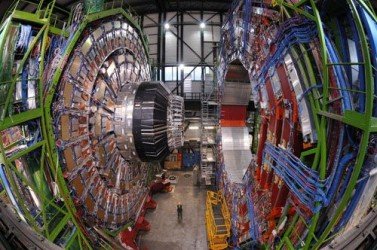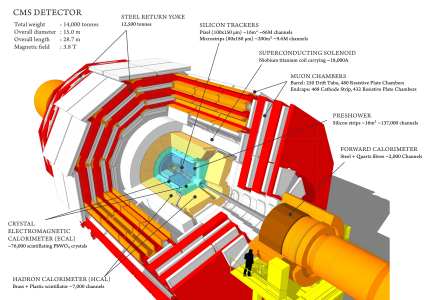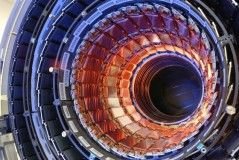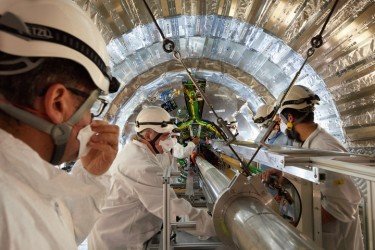Live from CERN - CMS got a heart transplant
The CMS experiment is one of the big four experiments of the LHC.
It recently got one of its more internal parts replaced, which is an event I use as an excuse to briefly discuss how a particle physics typical detector works. The reason of this replacement is very simple to get. It is simply due to the large collision rate occurring at the LHC (about a billion collisions per second).
TALKING ABOUT THE LHC?
I have learned about the replacement of the CMS tracker some time ago already. After all, I am one of the few theorists attached to the CMS experiment.
This means, in a few words, that I can participate to the internal CMS discussions, analyses, etc, but I am not involved, by choice, in any of the everyday-life experimental service tasks. As a result, I am also not signing any of the numerous CMS publications (that contain each thousands of authors)[3], except if I really contribute to them (there is so far one publication and two analysis notes which I contributed to).
After reading about the CMS tracker transplantation in one of the CERN bulletin [1, 2], I started to think about the fact that I have discussed a lot of non LHC experiments occurring at CERN, but never really any of the LHC experiments themselves.
It is therefore time to fill this gap! :)
THE CMS EXPERIMENT AT THE LHC

[image credits: CMS @ CERN]
The CMS experiment[4] is one of the two general-purpose experiments performed around the Large Hadron Collider, the LHC, at CERN.
Just to recapitulate a little bit, the LHC is the largest particle physics accelerator that exists today. It accelerates protons before smashing them together into very energetic collisions. As a result of these collisions, many things can happen, the most likely of these things being: nothing happens.
This is the reason why we need a lot of collisions, so that the rate with which something interesting could happen is large enough to actually observe something. We are actually talking about billions of collisions per second.
But a discovery (or the study of some known phenomena) can only be made after the results of the collisions are recorded and studied.
This is what the CMS experiment does: it records some of the collisions with interesting features (these features rendering these collisions not too boring). Not all collisions can be recorded for the simple reason that the collision rate is too large so that one is able to record everything (electronics limitations, etc.). But we do not have to worry too much, the rate associated with interesting physics is more than fine.
With the recorded data, we aim, in particular, to unravel new phenomena that could potentially bring an answer to one or more than one of the fundamental questions high-energy physicists are trying to answer. For instance, we can think about the nature of the universe, the dark matter, etc.
THE CMS DETECTOR IN A NUTSHELL

[image credits: CMS @ CERN]
The CMS detector has been designed to be able to reconstruct a wide range of particles arising from highly energetic LHC collisions.
It has a onion structure. This means what it means: the CMS detector looks like an onion! Really!
An onion is made of several layers, as the CMS detector, as shown by the different layers being indicated by various colors on the picture on the left.
Each layer of the detector has a very specific usage, collecting information of a given type. And the end of the day, when all the pieces of information are put together, one is able to draw conclusive statements about the nature of this or that particle, and finally about what happened during the collision.
One of the strengths of the CMS detector lies in the reconstruction of particles called muons, but as well as in the one of electrons and photons.
On top of that, CMS is able to very accurately measure the reconstructed particle properties and to record all the information associated with a collision (not a single visible collision product could espace).
This has influenced the way in which CMS has been designed, and it contains a strong magnet that have essentially given its name to the experiment. CMS indeed stands for a ‘Compact Muon Solenoid”.
As one can guess from its name, CMS is a dwarf particle physics detector, with small dimensions of 13m in length and 7m in diameter. This is actually small compared to ATLAS, for instance.
CMS is in contrast very heavy (more than 10.000 tonnes). Just to flash a few other numbers, the detector operates at a temperature slightly warmer than in outer space (-268.5 Celsius), has a magnetic field 100.000 times stronger than the magnetic field of Earth and is capable to store an amount of energy large enough to melt 18 tonnes of gold!
PARTICLE IDENTIFICATION WITH CMS
As said above, CMS reconstructs the different particles when they interact with the detector material (the information being passed thanks to the detector electronics).
The innermost part of the detector is called the tracker and allows for reconstructing the tracks of the charged particles. Charged particles follow bended paths due to the strong magnetic field of CMS. The curvature of the tracks then allows to deduce the particle momenta. This is the dark green heart of CMS shown on the above picture.
The light green layer of detector around the CMS detector is the electromagnetic calorimeter that is itself surrounded by the hadronic calorimeter (in yellow). These detector layers allow for the measurement of the particle energies, both for the electrons and photons (mostly the electromagnetic part of the calorimeter) and the jets of strongly interacting particles (mostly the hadronic part of the calorimeter).
The detector then includes the magnet that we have already mentioned (in white), followed by muon chambers as the outermost detector components. Muons are the only particles capable to reach that part of the detector.
THE CMS TRACKER AND ITS TRANSPLANTATION

[image credits: CMS @ CERN]
As said above, the tracker is the innermost part of the CMS detector. It is hence the first part of the detector with which any produced particle will interact so that it receives the higher amount of particles compared to the other components of the detector. It must therefore both be a precision device and resist to radiation!
The conditions of the CMS experiment have however evolved since the start of the LHC exploitation, and the initial tracker was designed for a much lower collision rate. Therefore, it has been replaced a couple of weeks ago.

[image credits: CERN]
The newly installed tracker guarantees the CMS detector to be able to work in optimal conditions, in particular in terms of the rate at which information must be recorded today and in the following years. The new detector is faster, more precise and also lighter.
What is still needed is a calibration stage, but things will be ready very soon. The new data taking period will then start in a couple of weeks.
The idea behind this replacement is that the current tracker must be able to follow the LHC power-up of the next few years. It will however have to be replaced in 2024 for the high-luminosity run of the LHC.
But this is for another story :)
SUMMARY
In this post, I discussed the CMS experiment at CERN, one of the four big experiments running around the LHC. The innermost part of the CMS detector, its tracker, has been recently replaced and I took this event as an excuse to detail a little bit what CMS does and how a general-purpose detector in particle physics works.
Just to recap, CMS is a small very heavy detector relying on a very intense magnetic field for particle identification. Each part of the detector has a well defined task to accomplish, and all the information put together allow high-energy physicists to draw conclusions on what happened in a given collision.
We only now have to wait for observing the unexpected ^^
REFERENCES
- [1] The CERN bulletin (from 14.03.2017), in French.
- [2] The March 2017 CERN article on the CMS tracker, in English this time ;)
- [3] The list of all CMS publications. Be careful, a few links to follow before getting to them.
- [4] The CMS official website. Please follow the links given there for more information.
Another great post of high quality and high interest for me. Thanks a bunch for your sharing, once again, and namaste :)
Thanks a lot for your nice comment!
#Science Rocks!
Science always rocks! :D
WOUuuuuu, now thats an interesting over my head post that I really enjoyed reading! Thanks for the hard work.
Now, just a question that bothers my head since school days...
Has a photon got any mass or not?
Steem ON!
The photon is definitely massless. That is a theoretical prediction. Even a super strong one, actually.
There are experiments trying to falsify this statement. They have however so fair all failed, and the resulting upper limit on the photon mass is something like 10-18 eV, which is about 1.7 x 10-54 kg. The information can be found in the 2016 Particle Data Group review.
Thanks for your nice comment by the way!
I shall sleep better tonigh.
thanks to you, my steem friend.
I shall press the Follow button
Thanks a lot for this! Do not hesitate to come back to me in the case you would have any question! :)
Interesting project I have been following the Cern project for a while so keep doing what your doing.
Thank you for your comment!
Thank you for this very interesting read and the first-hand insight into what´s going on at CERN! Looking forward to the next post about the high-luminosity experiment. Sounds like something very bright :-)
This is actually slightly too early to discuss it. More information about the High-Lumi LHC project can be found here, and the discussions are actually speeding up. As soon as things will get more concrete, I will be happy to write about it!
This is very interesting and also gave me a new topic to discuss in class tomorrow. (Hope you are well, I have been so busy I have no time to write. )
I have also been very busy on my side and had to reduce my steemit presence and posting rhythm. Do not hesitate to share the news and ask your students to contact me if they want further pieces of information! It will be my pleasure!
Thank you I shall do so. As long as you don't disappear you can post less. 😁
I will not disappear. Don't worry, you need more than that for dismantle me ;)
Filled with lots of unknown information about CERN, this article gives a thorough understanding of experiments and processes associated with the Large Hadron Collider, the LHC, at CERN.
That was the idea, indeed ;) Thanks for your comment!
This is absolutely fascinating. Thanks for sharing an insider's look at this groundbreaking tech!
My pleasure :)
Thank you for sharing these information with us
It is my pleasure!
Is a very interesting article, I congratulate you
Thanks, but why congratulating? :)
I congratulate you for the information you share. It's a good job
ah ok thank you then ^^